Optimization and Assessment of the Protective Shed of the Eastern Wu Tomb
Abstract
1. Introduction
2. Modeling of Eastern Wu Tomb
2.1. Hygrothermal Transfer Equations
2.1.1. Boundary Condition
2.1.2. Heat and Moisture Balance in the Tomb Chamber and the Protective Shed
2.2. Monitoring of Meteorological Conditions and Indoor Environment
2.3. Material Used in the Model
2.4. Simulation Procedures
2.5. Model Validation
3. Optimization of Protective Shed Design with a Functional Space
4. Results and Discussion
4.1. Changes of Surface Temperature and Water Content on the Internal Wall
4.2. Changes of the Air Temperature and Humidity in the Tomb Chamber
4.3. Occurrence in Condensation
5. Conclusions
Author Contributions
Funding
Conflicts of Interest
References
- Wang, Z.; Ma, T.; Gong, J. Surmising the Tomb Owner of the Eastern Wu at Shangfang Village, Jiangning District, Nanjing: Concurrently Discussing the Clan Tombs of the Eastern Wu. Southeast Cult. 2009, 3, 41–50. [Google Scholar]
- Wang, Z.; Ma, T.; Gong, J.; Zhou, W.; Xu, C.; Zhou, R.; Cui, S.; Dong, B.; Wang, Q.; Li, Y. Excavation of the tomb of State Wu of the Three Kingdoms Period in Shangfang town, Nanjing City. Cult. Reli. 2008, 12, 4–35. [Google Scholar]
- Kiurski, J.S.; Ranogajec, J.G.; Ujhelji, A.L.; Radeka, M.M.; Bokorov, M.T. Evaluation of the effect of lichens on ceramic roofing tiles by scanning electron microscopy and energy-dispersive spectroscopy analyses. Scanning 2005, 27, 113–119. [Google Scholar] [CrossRef] [PubMed]
- Radeka, M.; Kiurski, J.; Markov, S.; Marinkovi-Neduin, R.; Ranogajec, J. Microbial deterioration of clay roofing tiles. In WIT Transactions on the Built Environment; WIT Press: Ashurst, UK, 2007; Volume 95, pp. 567–575. [Google Scholar] [CrossRef]
- Vasanthakumar, A.; DeAraujo, A.; Mazurek, J.; Schilling, M.; Mitchell, R. Microbiological survey for analysis of the brown spots on the walls of the tomb of King Tutankhamun. Int. Biodeterior. Biodegrad. 2013, 79, 56–63. [Google Scholar] [CrossRef]
- Savković, Ž.; Unković, N.; Stupar, M.; Franković, M.; Jovanović, M.; Erić, S.; Šarić, K.; Stanković, S.; Dimkić, I.; Vukojević, J.; et al. Diversity and biodeteriorative potential of fungal dwellers on ancient stone stela. Int. Biodeterior. Biodegrad. 2016, 115, 212–223. [Google Scholar] [CrossRef]
- Tonon, C.; Favero-Longo, S.E.; Matteucci, E.; Piervittori, R.; Croveri, P.; Appolonia, L.; Meirano, V.; Serino, M.; Elia, D. Microenvironmental features drive the distribution of lichens in the House of the Ancient Hunt, Pompeii, Italy. Int. Biodeterior. Biodegrad. 2019, 136, 71–81. [Google Scholar] [CrossRef]
- Larbi, J.A. Microscopy applied to the diagnosis of the deterioration of brick masonry. Constr. Build. Mater. 2004, 18, 299–307. [Google Scholar] [CrossRef]
- Ranogajec, J.; Radosavljević, S.; Marinković-Nedućin, R.; Živanović, B. Chemical corrosion phenomena of roofing tiles. Ceram. Int. 1997, 23, 99–103. [Google Scholar] [CrossRef]
- Albertano, P.; Bruno, L.; Bellezza, S.; Paradossi, G. Polysaccharides as a Key Step in Stone Bio-Erosion. In Proceedings of the 9th International Congress on Deterioration and Conservation of Stone, Venice, Italy, 19–24 June 2000; Elsevier: Amsterdam, The Netherlands, 2000; pp. 425–432. [Google Scholar] [CrossRef]
- Suihko, M.L.; Alakomi, H.L.; Gorbushina, A.; Fortune, I.; Marquardt, J.; Saarela, M. Characterization of aerobic bacterial and fungal microbiota on surfaces of historic Scottish monuments. Syst. Appl. Microbiol. 2007, 30, 494–508. [Google Scholar] [CrossRef]
- Hyvärinen, A.; Meklin, T.; Vepsäläinen, A.; Nevalainen, A. Fungi and actinobacteria in moisture-damaged building materials—Concentrations and diversity. Int. Biodeterior. Biodegrad. 2002, 49, 27–37. [Google Scholar] [CrossRef]
- Smith, S.L.; Hill, S.T. Influence of temperature and water activity on germination and growth of Aspergillus restrictus and A. versicolor. Trans. Br. Mycol. Soc. 1982, 79, 558–560. [Google Scholar] [CrossRef]
- Sedlbauer, K.; Krus, M. A New Model for Mould Prediction and Its Application in Practice. In Proceedings of the 2nd International Conference on Building Physics, Antwerp, Belgium, 14–18 September 2003; pp. 921–927. [Google Scholar]
- Hens, H.; Senave, E. IEA Annex 14: The Zolder Case Study. Indoor Air 1991, 1, 213–228. [Google Scholar] [CrossRef]
- Vereecken, E.; Roels, S. Review of mould prediction models and their influence on mould risk evaluation. Build. Environ. 2012, 51, 296–310. [Google Scholar] [CrossRef]
- Grant, C.; Hunter, C.A.; Flannigan, B.; Bravery, A.F. The moisture requirements of moulds isolated from domestic dwellings. Int. Biodeterior. 1989, 25, 259–284. [Google Scholar] [CrossRef]
- Bastian, F.; Jurado, V.; Nováková, A.; Alabouvette, C.; Saiz-Jimenez, C. The microbiology of Lascaux Cave. Microbiology 2010, 156, 644–652. [Google Scholar] [CrossRef] [PubMed]
- Saiz-Jimenez, C.; Cuezva, S.; Jurado, V.; Fernandez-Cortes, A.; Porca, E.; Benavente, D.; Cañaveras, J.C.; Sanchez-Moral, S. Paleolithic art in peril: Policy and science collide at altamira cave. Science 2011, 334, 42–43. [Google Scholar] [CrossRef]
- Saiz-Jimenez, C. Microbiological and environmental issues in show caves. World J. Microbiol. Biotechnol. 2012, 28, 2453–2464. [Google Scholar] [CrossRef]
- Clarke, J.A.; Johnstone, C.M.; Kelly, N.J.; McLean, R.C.; Anderson, J.A.; Rowan, N.J.; Smith, J.E. A technique for the prediction of the conditions leading to mould growth in buildings. Build. Environ. 1999, 34, 515–521. [Google Scholar] [CrossRef]
- Rowan, N.J.; Johnstone, C.M.; McLean, R.C.; Anderson, J.G.; Clarke, J.A. Prediction of toxigenic fungal growth in buildings by using a novel modelling system. Appl. Environ. Microbiol. 1999, 65, 4814–4821. [Google Scholar] [CrossRef]
- Sedlbauer, K.; Krus, M.; Zillig, W.; Künzel, H.M. Mold Growth Prediction by Computational Simulation. In Proceedings of the IAQ Conference, San Francisco, CA, USA, 4–7 November 2001. [Google Scholar]
- Li, Y.; Ogura, D.; Hokoi, S.; Ishizaki, T. Effects of emergency preservation measures following excavation of mural paintings in Takamatsuzuka Tumulus. J. Build. Phys. 2012, 36, 117–139. [Google Scholar] [CrossRef]
- Hale, M. Control of Biological Growths on Mayan Archaeological Ruins in Guatemala and Honduras; National Geographic Research Reports: Washington, DC, USA, 1980. [Google Scholar]
- Huang, G.; Ye, L.; Lan, X.; Chen, H.; Li, J.; Liu, C. The inhibitory effect of Kathon on the mildew on the surface of Bailiandong Site in Liuzhou. J. Guangxi Univ. Sci. Technol. 2019, 30, 97–106. [Google Scholar] [CrossRef]
- Xia, Y.; Zhang, M.; Zhang, S.; Fu, Q.; Huang, J.; Yan, S.; Sun, Z.; Xu, J.; Zhou, T. Progress in the prevention and treatment of soluble salt and fungus damage on soil site in the museum. Sci. Conserv. Archaeol. 2013, 25, 114–119. [Google Scholar] [CrossRef]
- Helmi, F.M.; Ali, N.M.; Ismael, S.M. Nanomaterials for the inhibition of microbial growth on ancient Egyptian funeral masks. Mediterr. Archaeol. Archaeom. 2015, 15, 87–95. [Google Scholar] [CrossRef]
- Li, Y.; Wang, L. Research progress of Nano material applied to the conservation of cultural heritage. Mater. Rep. 2011, 25, 34–37. [Google Scholar] [CrossRef]
- Pandey, J.K.; Raghunatha Reddy, K.; Pratheep Kumar, A.; Singh, R.P. An overview on the degradability of polymer nanocomposites. Polym. Degrad. Stab. 2005, 88, 234–250. [Google Scholar] [CrossRef]
- Matsumoto, M. Simultaneous Heat and Moisture Transfer and Moisture Accumulation in Building Materials. Ph.D. Thesis, Kyoto University, Kyoto, Japan, 1978. [Google Scholar]
- Matsumoto, M.; Hokoi, S.; Hatano, M. Model for simulation of freezing and thawing processes in building materials. Build. Environ. 2001, 36, 733–742. [Google Scholar] [CrossRef]
- Arya, L.M.; Leij, F.J.; Shouse, P.J.; van Genuchten, M.T. Relationship between the Hydraulic Conductivity Function and the Particle-Size Distribution. Soil Sci. Soc. Am. J. 1999, 63, 1063–1070. [Google Scholar] [CrossRef]
- Dou, N. Research on Environental Control of Protection and Display Facilities for Brick Archeological Site—Taking the Sun Wu Tomb in Nanjing Shangfang as an Example. Master’s Thesis, Southeast University, Nanjing, China, 2018. [Google Scholar]
- Johansson, S.; Wadsö, L.; Sandin, K. Estimation of mould growth levels on rendered façades based on surface relative humidity and surface temperature measurements. Build. Environ. 2010, 45, 1153–1160. [Google Scholar] [CrossRef]
- Li, Y.; Ogura, D.; Hokoi, S.; Wang, J.; Ishizaki, T. Predicting hygrothermal behavior of an underground stone chamber with 3-D modeling to restrain water-related damage to mural paintings. J. Asian Archit. Build. Eng. 2014, 13, 499–506. [Google Scholar] [CrossRef]

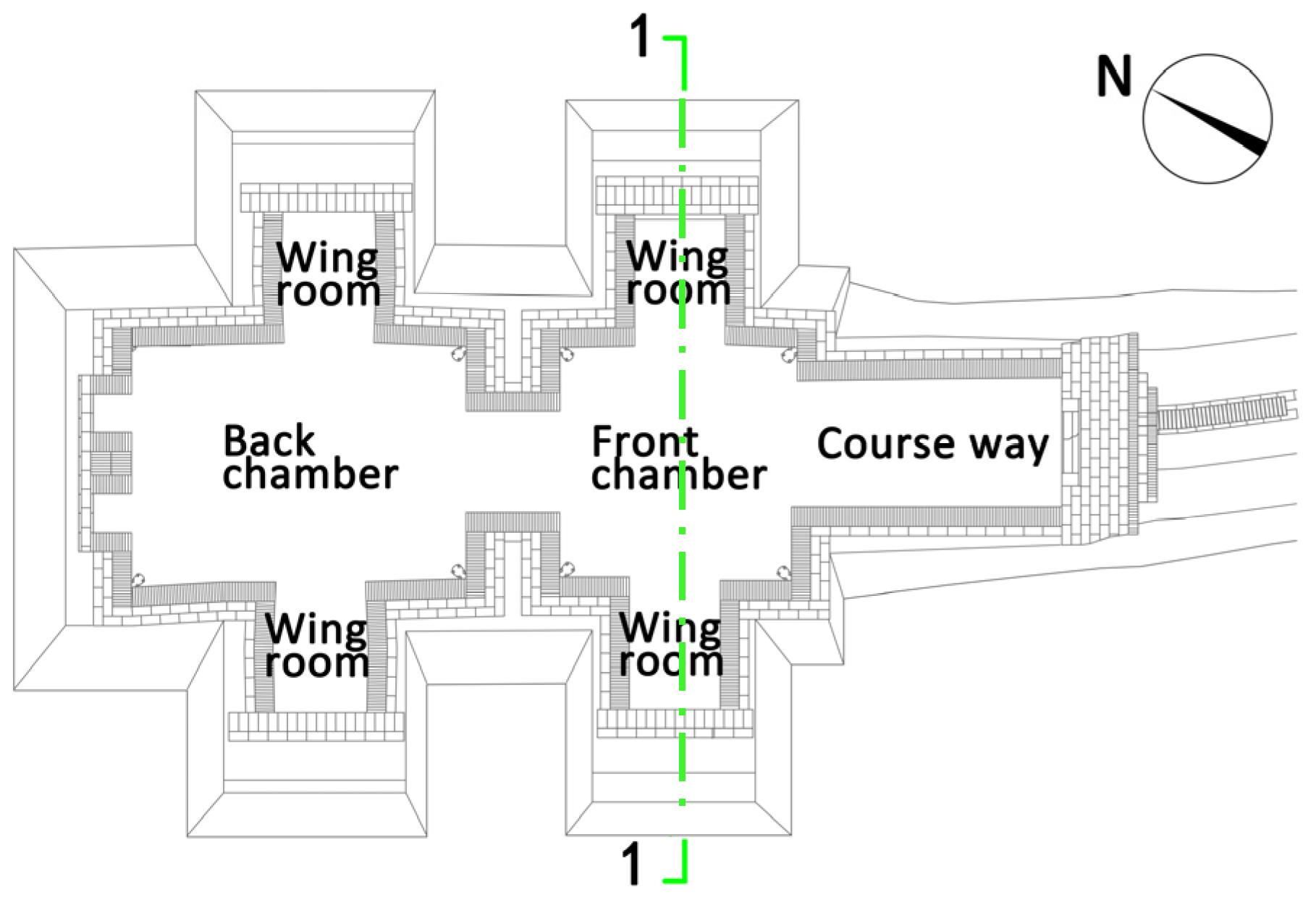


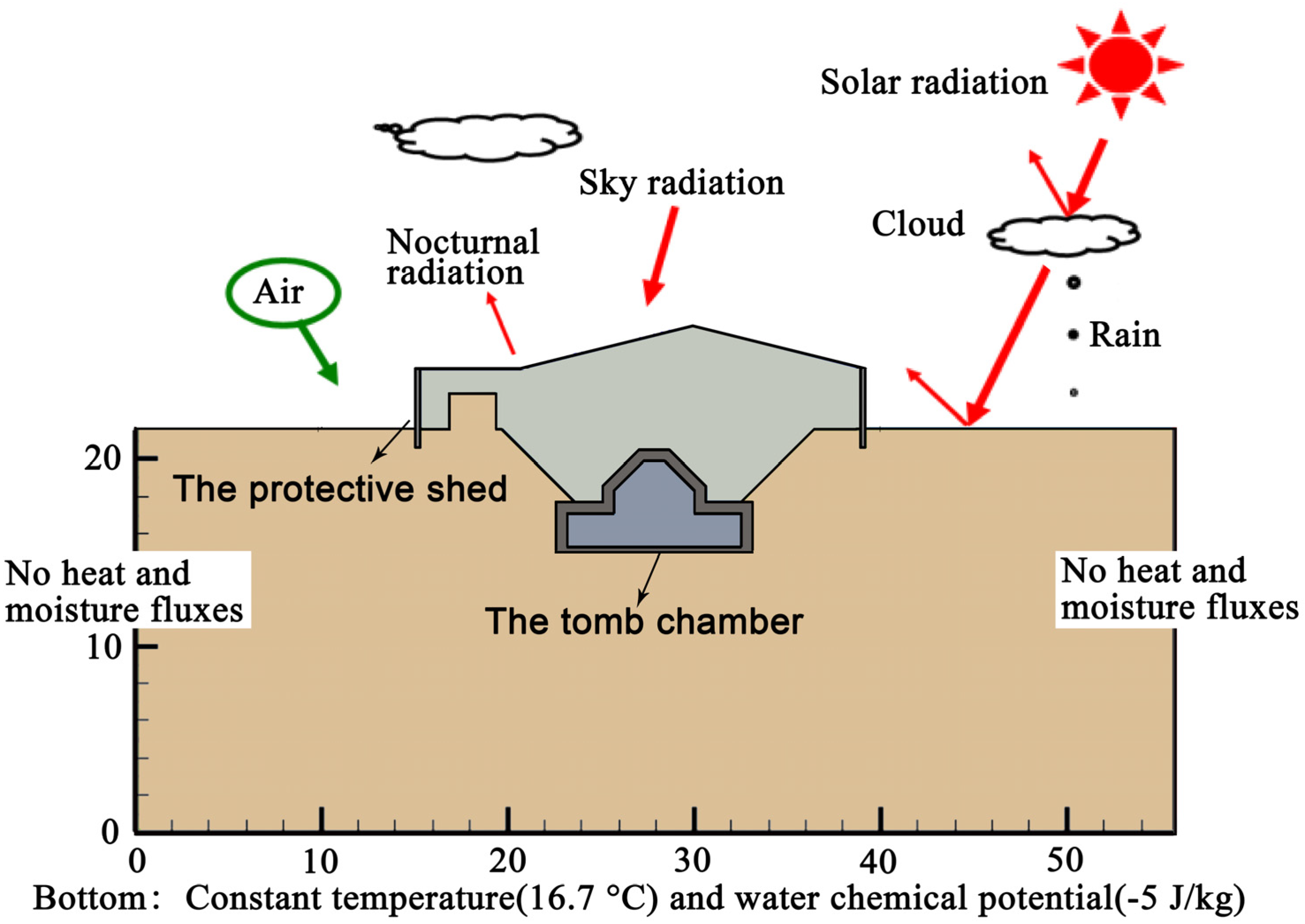

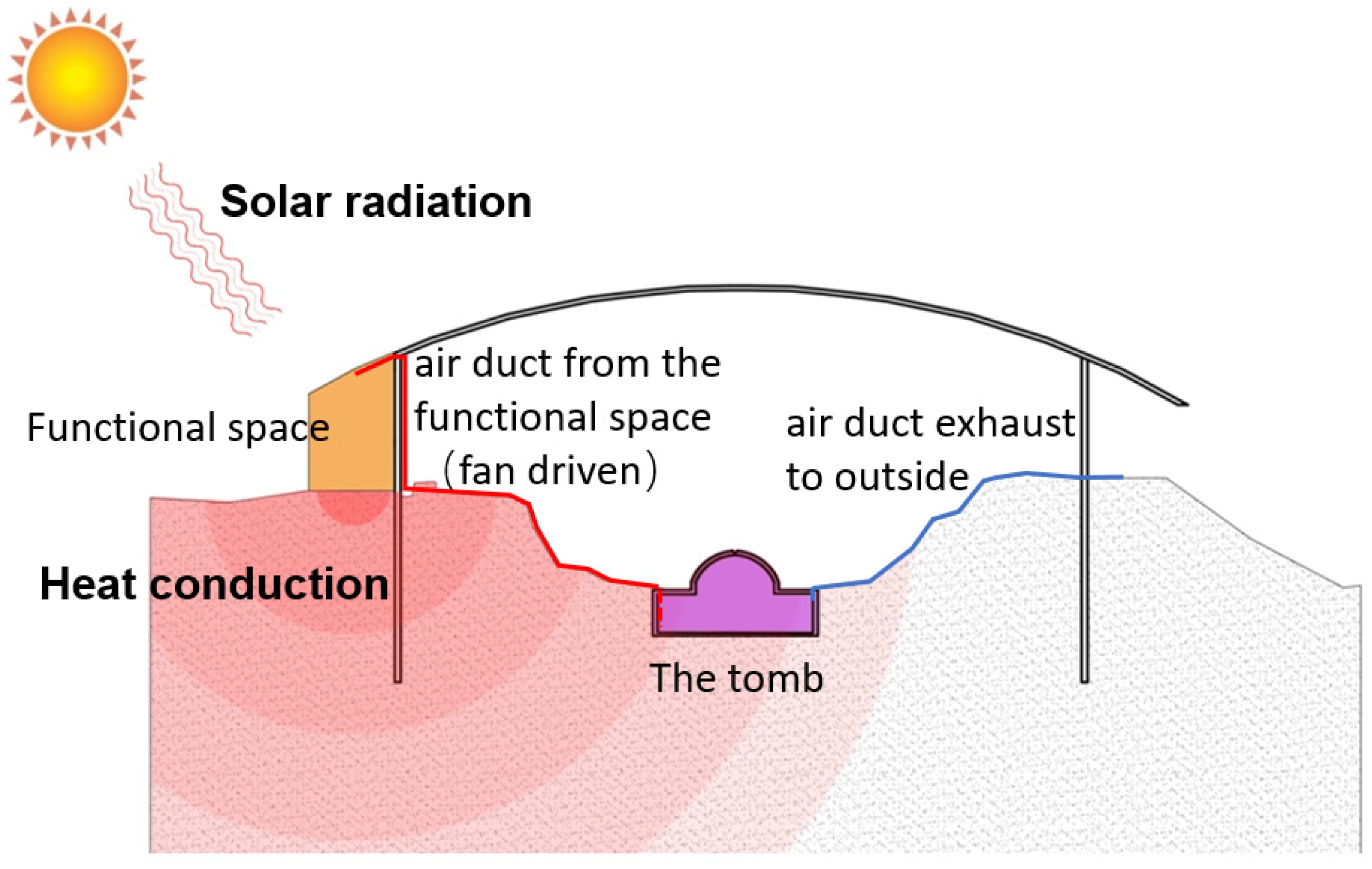
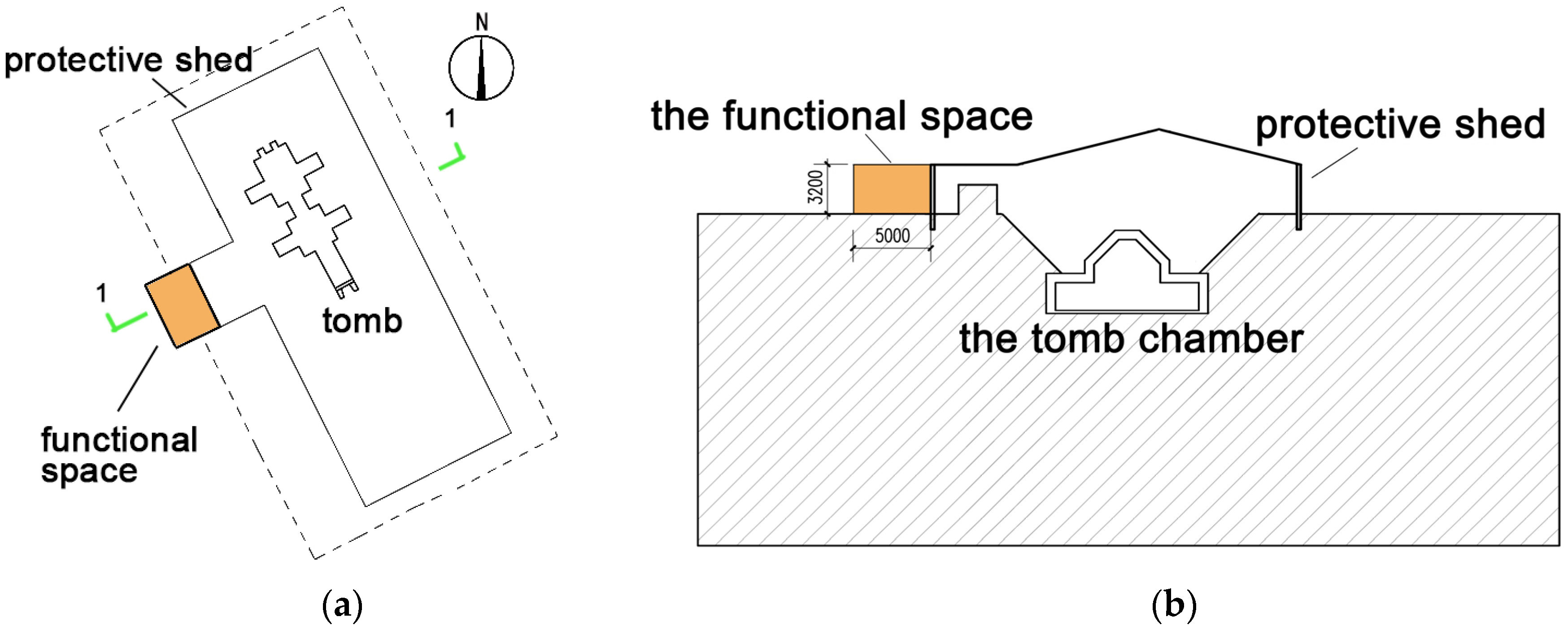

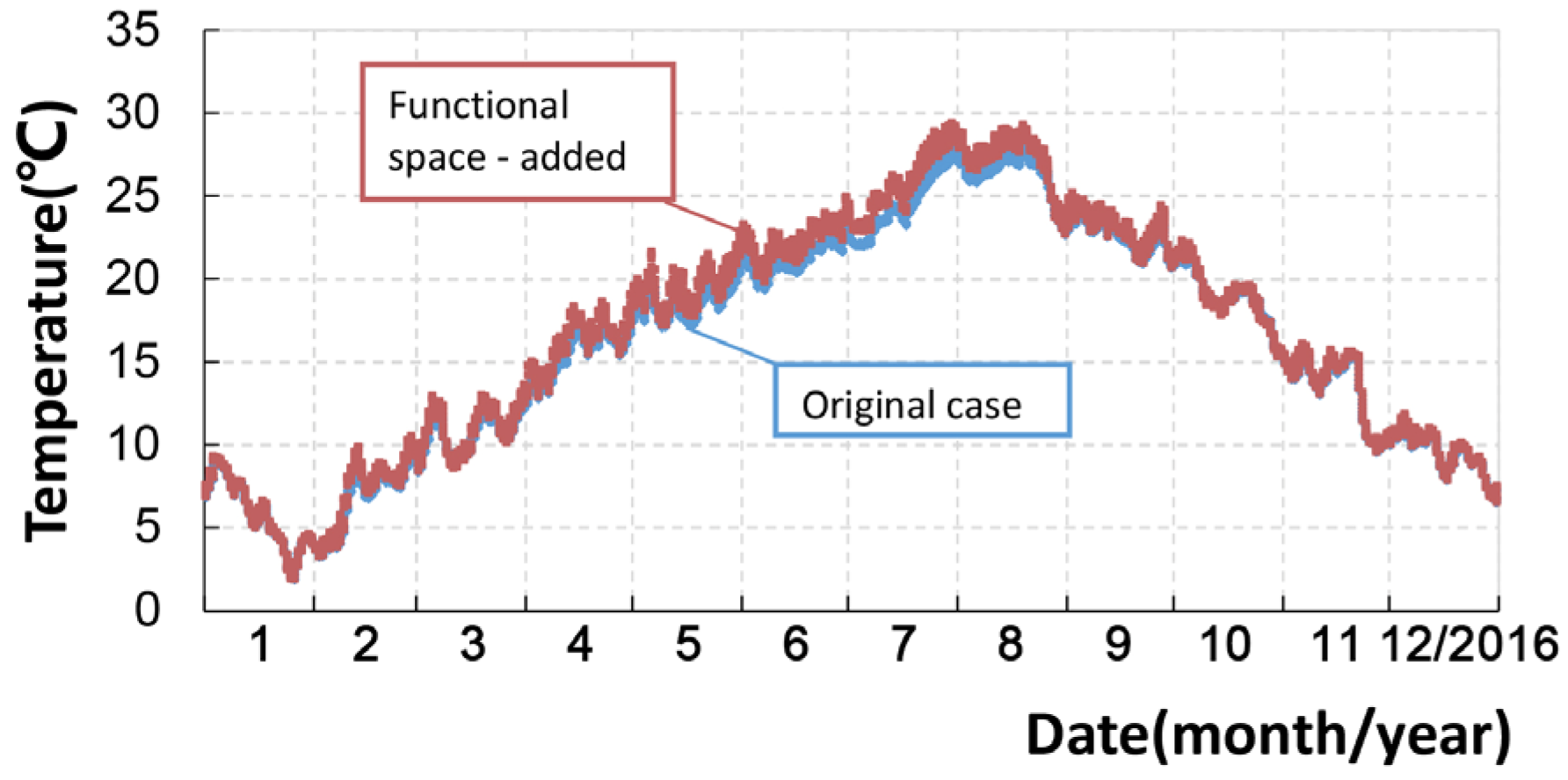
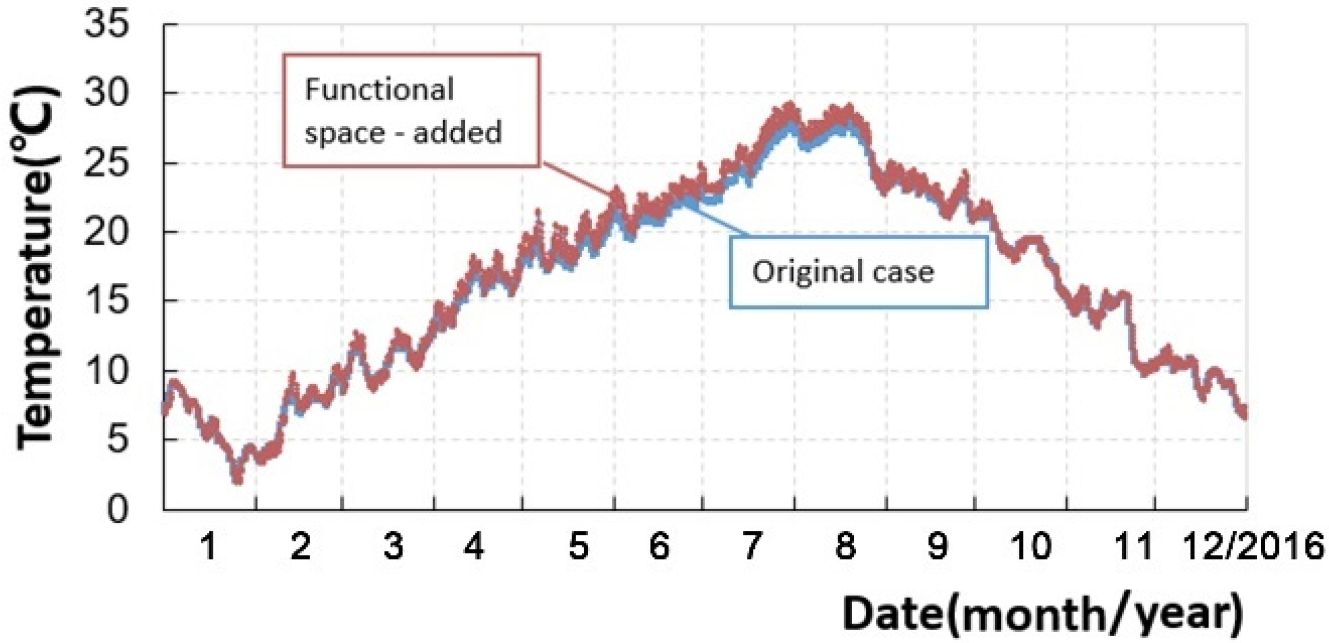
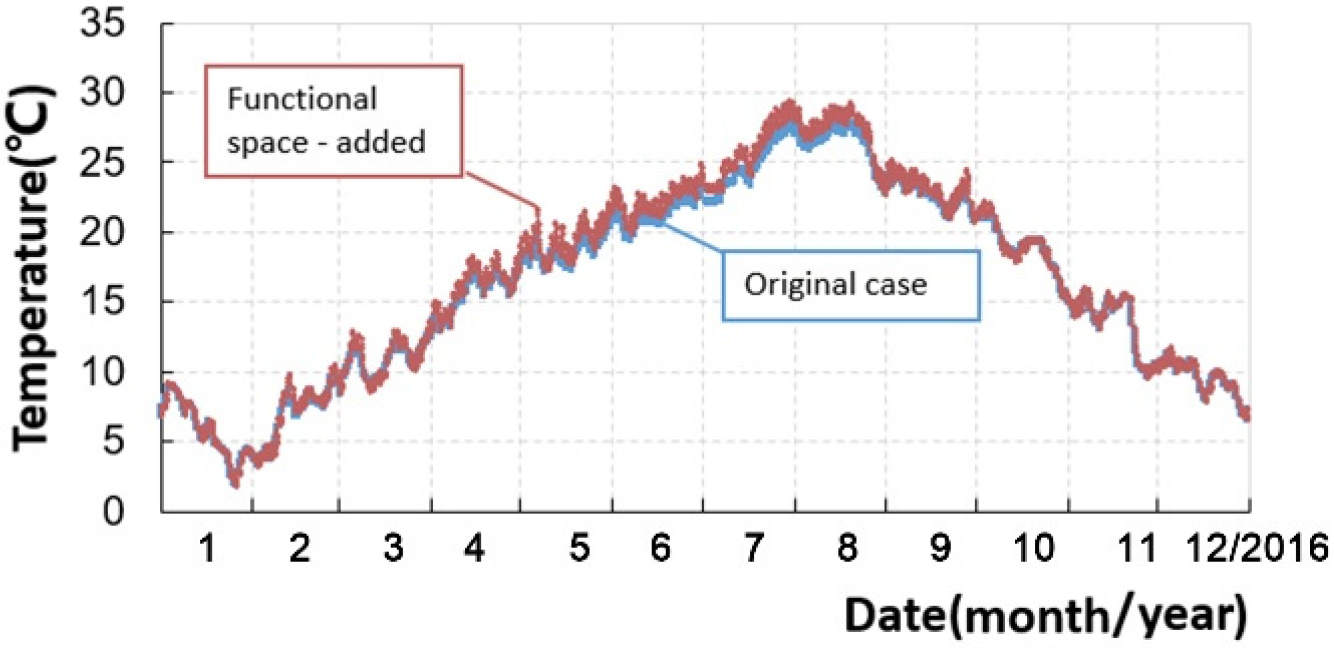
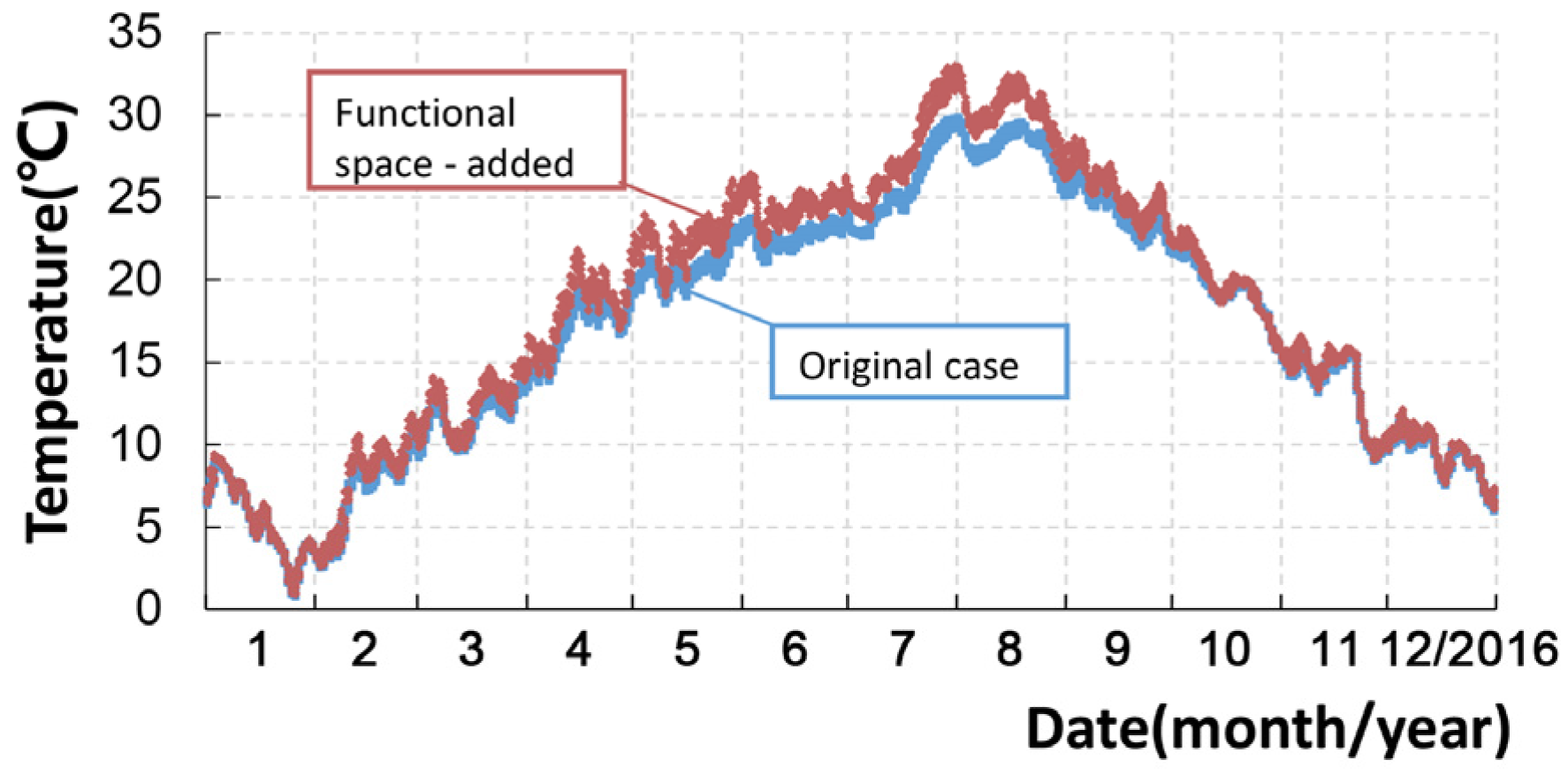
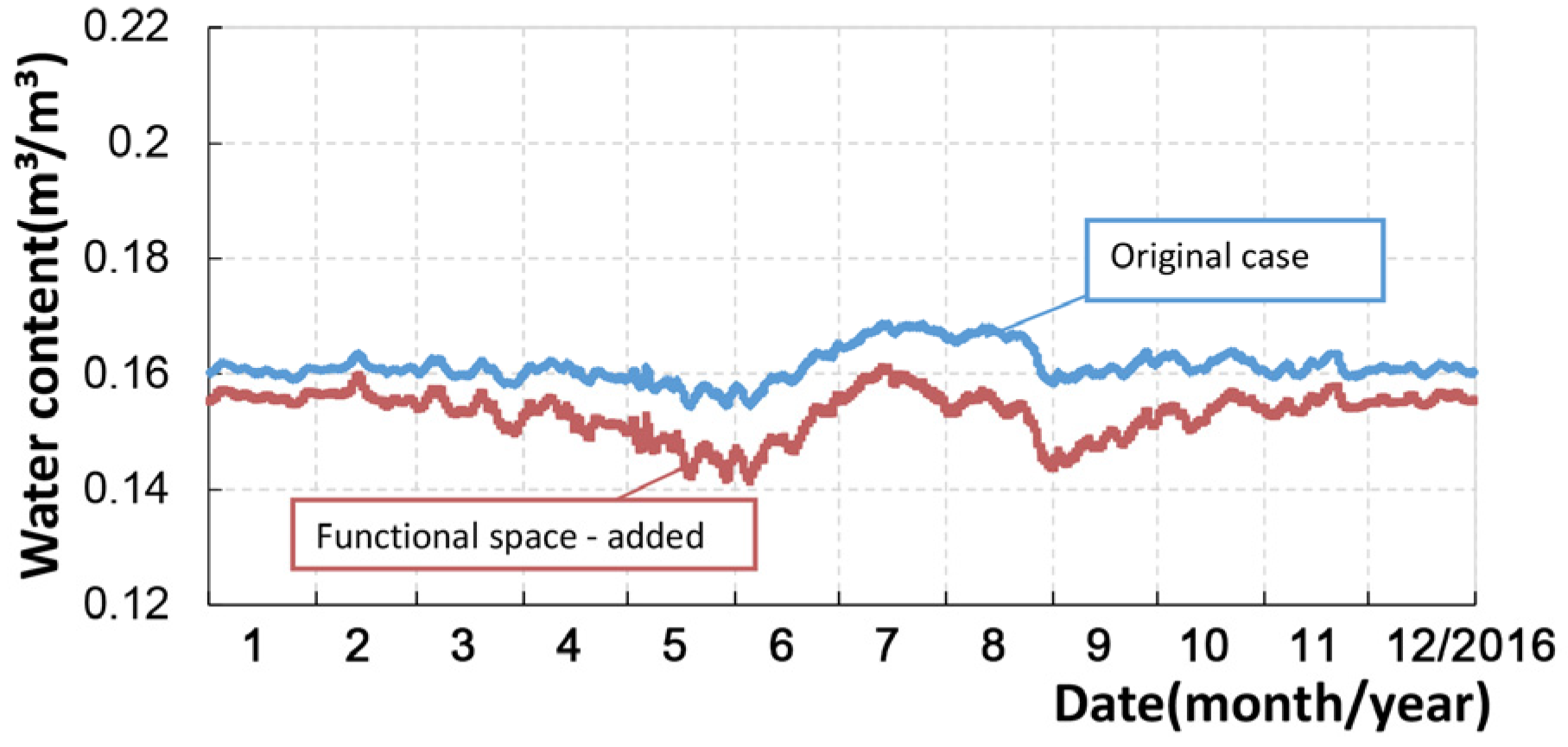
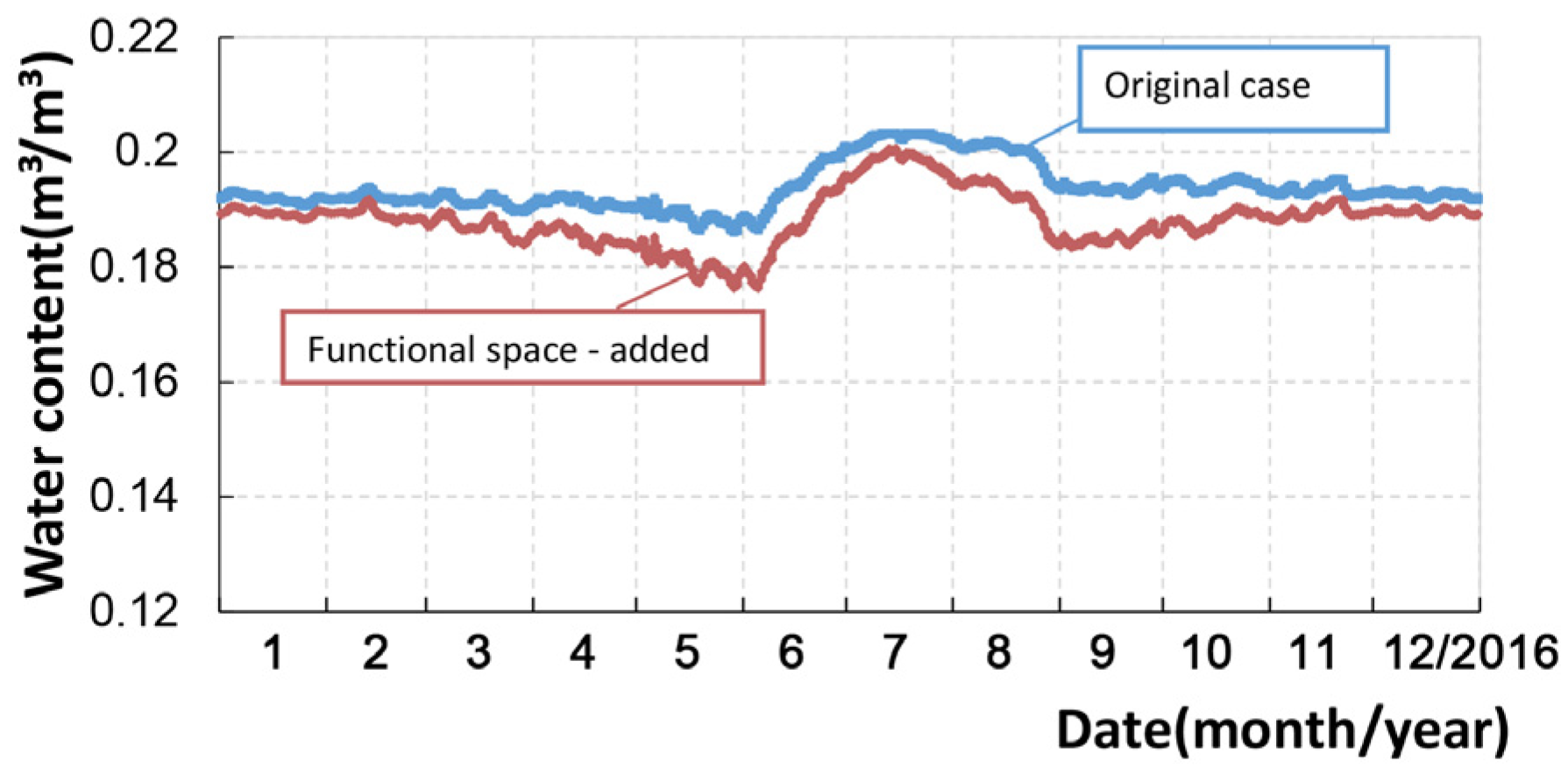

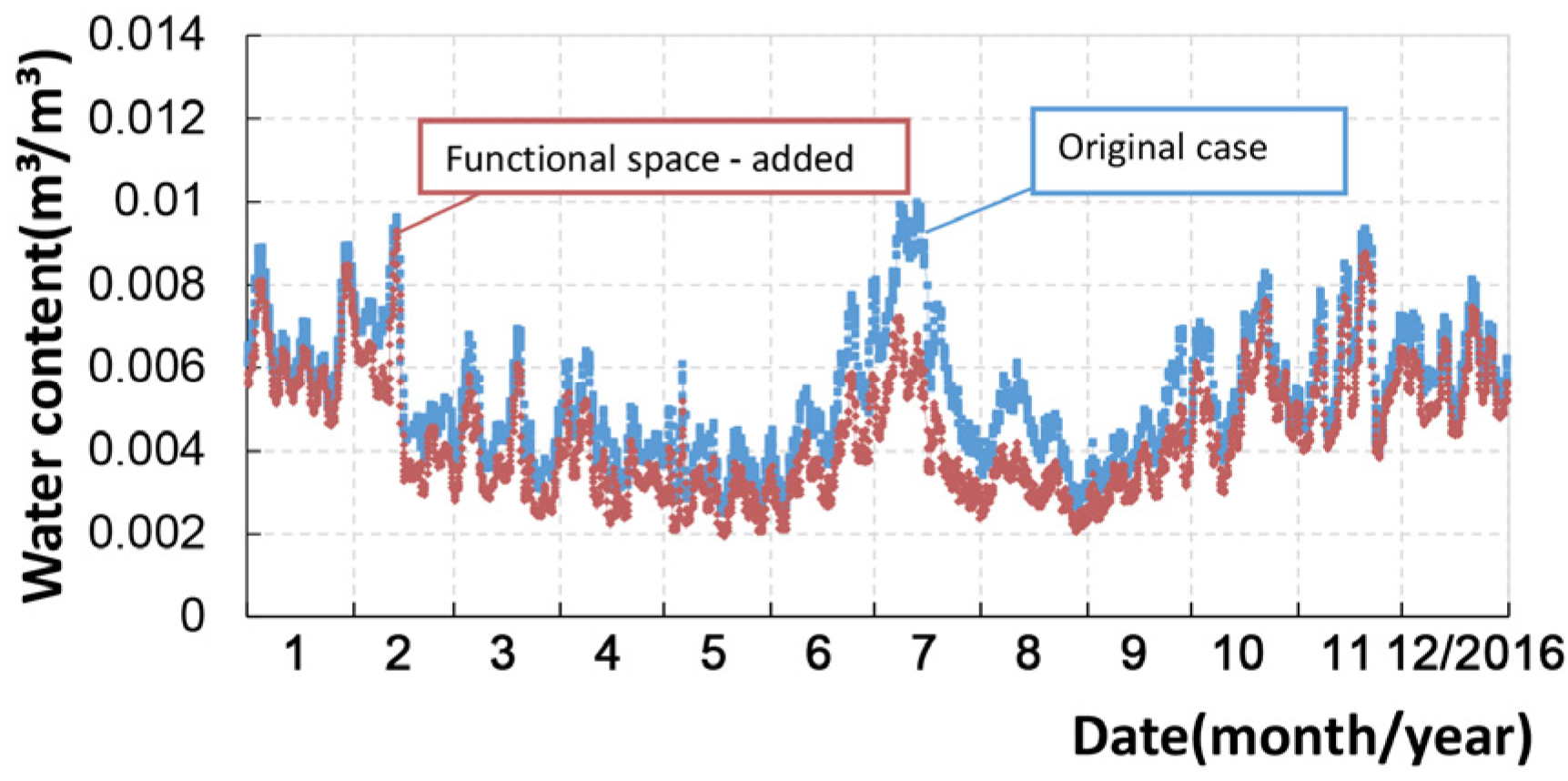
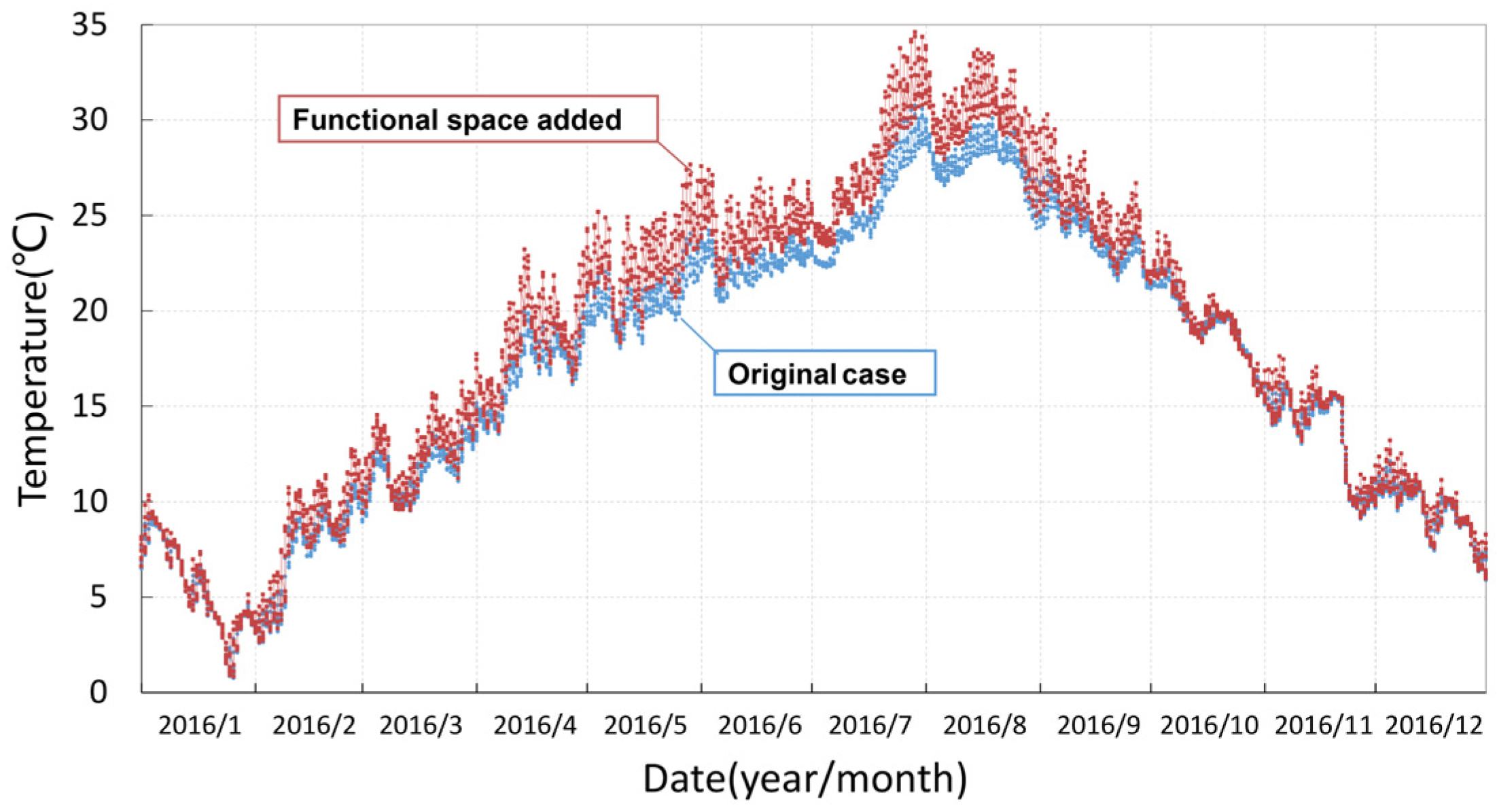
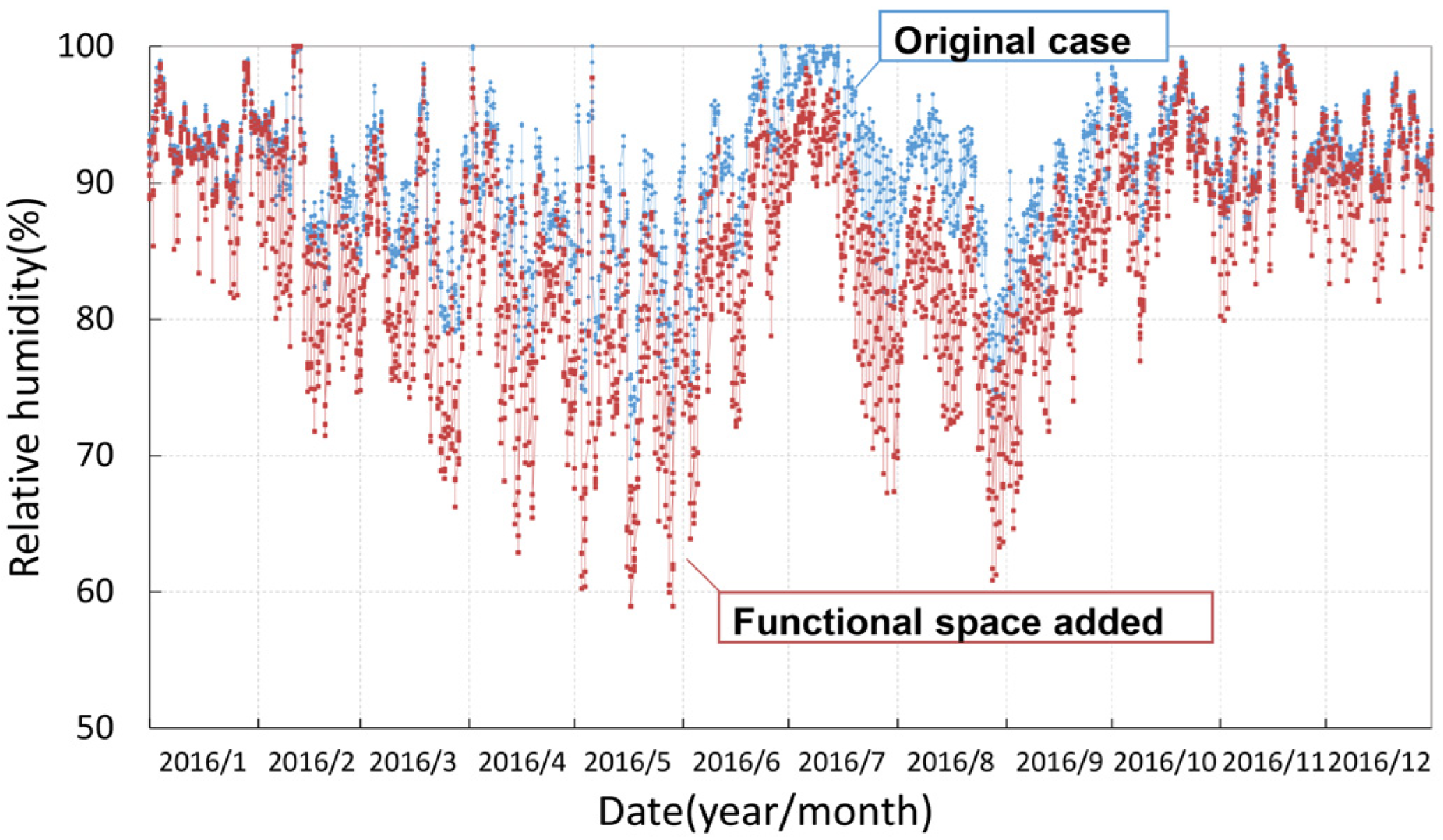

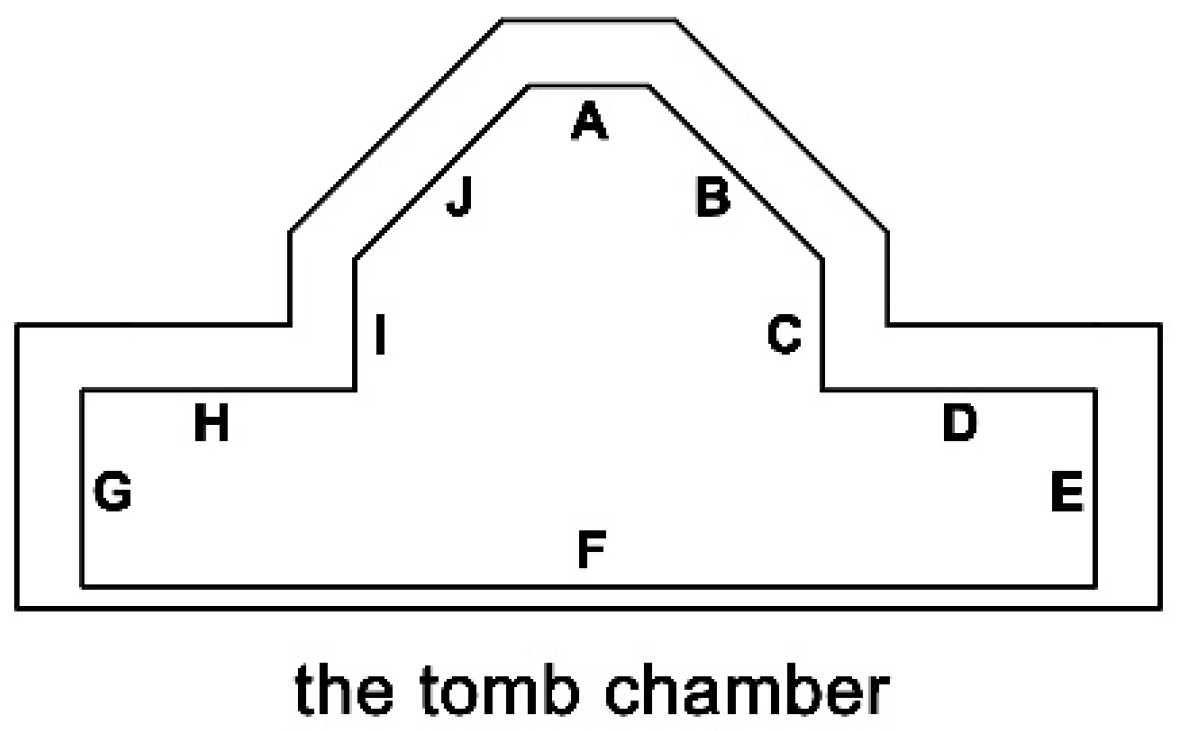
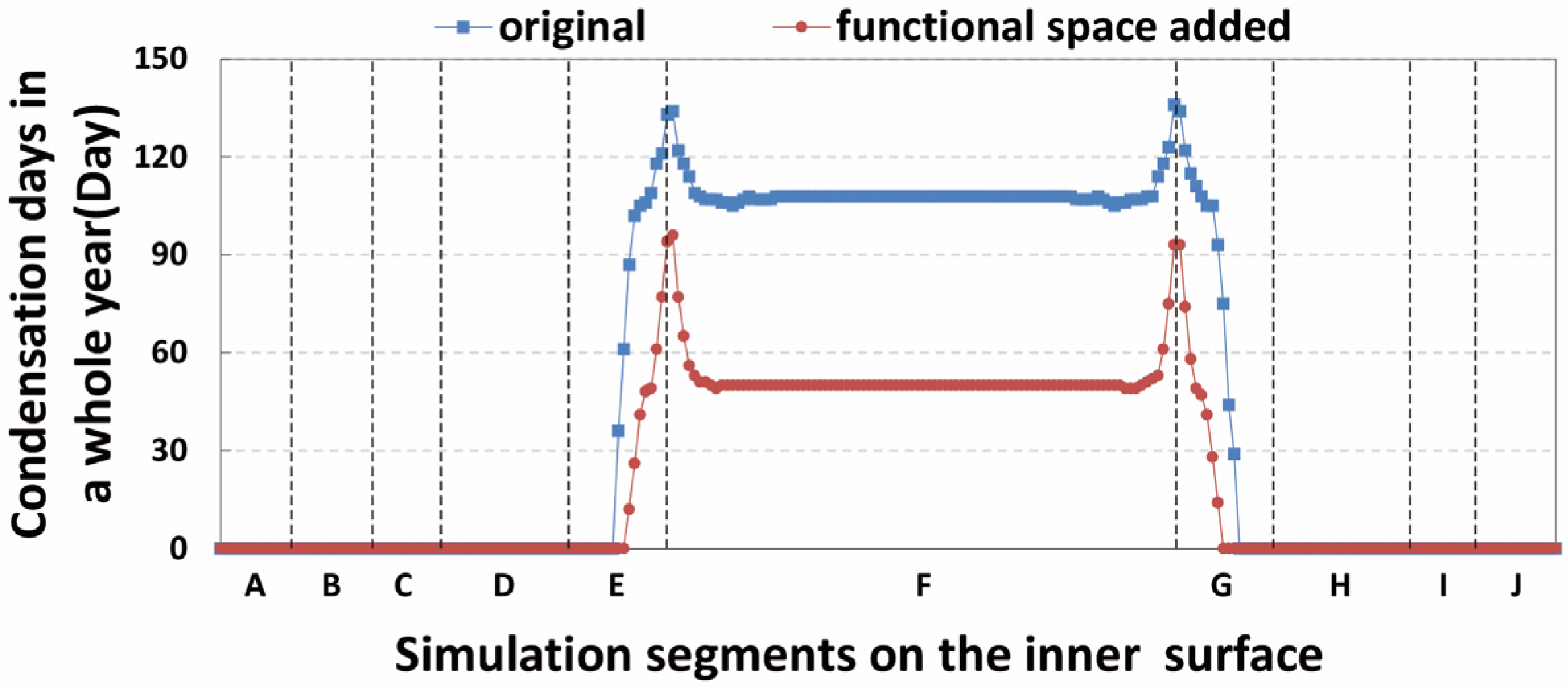
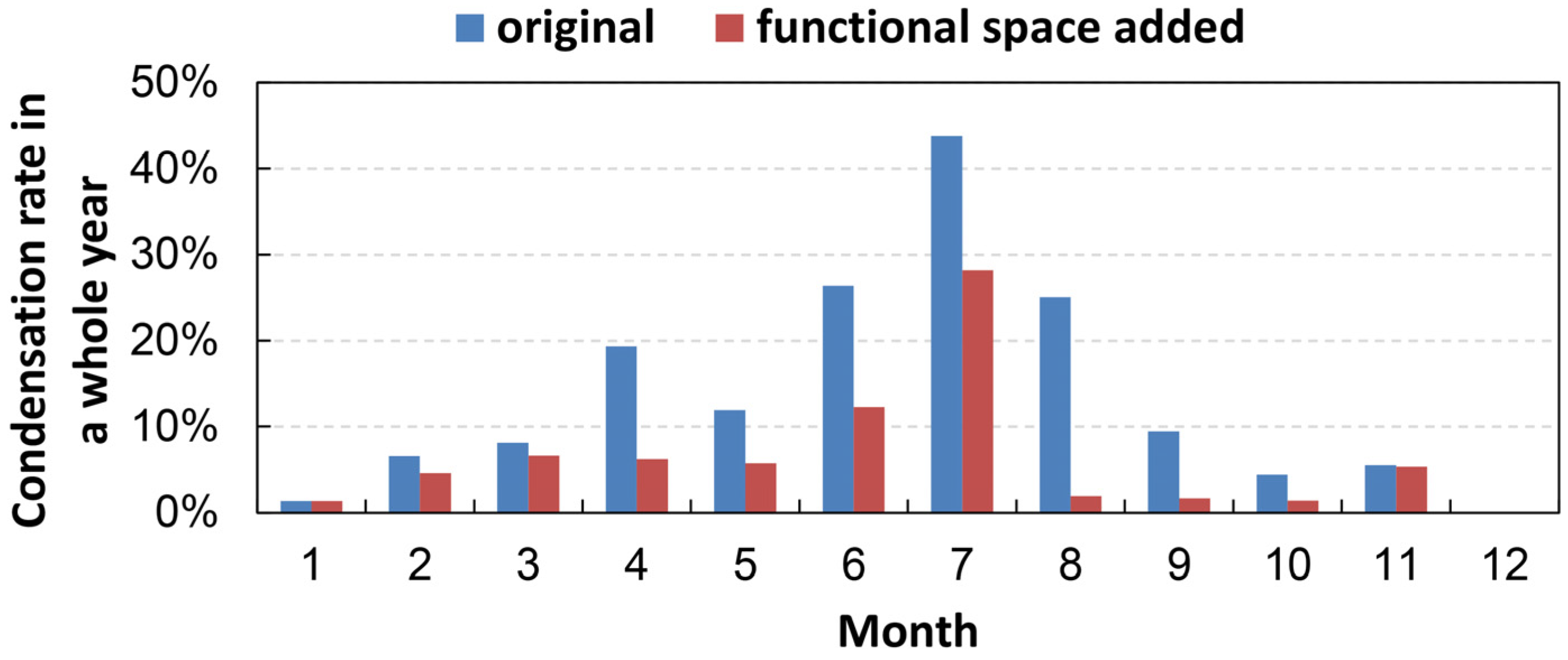
| Position | Air Exchange Rate (Times/Hour) |
|---|---|
| Between the tomb chamber and the protective shed | 3 |
| Between the protective shed and the outside | 3.2 |
| Conditions | Air Exchange Rate (Times/Hour) |
|---|---|
| March-October | 2 |
| January-February or November-December and Tf > Tr | 2 |
| January-February or November-December and Tf ≤ Tr | 0 |
| Statistics | Original Case (°C) | Functional Space Added (°C) | Difference (°C) |
|---|---|---|---|
| maximum | 30.7 | 34.6 | 3.9 |
| minimum | 0.7 | 0.8 | 0.1 |
| average | 17.0 | 18.2 | 1.2 |
| standard deviation | 7.4 | 8.1 | 0.7 |
| Statistics | Original Case | Functional Space Added | Difference |
|---|---|---|---|
| maximum | 100% | 100% | 0.0% |
| minimum | 69.8% | 58.9% | −10.9% |
| average | 90.6% | 85.6% | −5.0% |
| standard deviation | 5.3% | 8.0% | 2.7% |
| Statistics | Original Case (kg/m³) | Functional Space Added (kg/m³) | Difference (kg/m³) |
|---|---|---|---|
| maximum | 0.032 | 0.035 | 0.003 |
| minimum | 0.004 | 0.004 | 0 |
| average | 0.015 | 0.015 | 0 |
| standard deviation | 0.007 | 0.008 | 0.001 |
| Segment(s) | Original Case | Functional Space Added | Difference |
|---|---|---|---|
| E | 54 | 23 | −31 |
| F | 109 | 52 | −57 |
| G | 58 | 22 | −36 |
| E-G | 94 | 44 | −50 |
| Statistics | Original Case | Functional Space Added | Difference |
|---|---|---|---|
| January | 1.3% | 1.3% | −0.0% |
| February | 6.5% | 4.6% | −1.9% |
| March | 8.1% | 6.6% | −1.5% |
| April | 19.3% | 6.2% | −13.1% |
| May | 11.9% | 5.7% | −6.2% |
| June | 26.4% | 12.2% | −14.2% |
| July | 43.7% | 28.2% | −15.5% |
| August | 25.0% | 2.0% | −23.0% |
| September | 9.4% | 1.6% | −7.8% |
| October | 4.4% | 1.4% | −3.0% |
| November | 5.5% | 5.3% | −0.2% |
| December | 0 | 0 | −0.0% |
| Average (whole year) | 13.5% | 6.3% | −7.2% |
© 2020 by the authors. Licensee MDPI, Basel, Switzerland. This article is an open access article distributed under the terms and conditions of the Creative Commons Attribution (CC BY) license (http://creativecommons.org/licenses/by/4.0/).
Share and Cite
Li, Y.; Feng, Y.; Kong, Z.; Hokoi, S. Optimization and Assessment of the Protective Shed of the Eastern Wu Tomb. Energies 2020, 13, 1652. https://doi.org/10.3390/en13071652
Li Y, Feng Y, Kong Z, Hokoi S. Optimization and Assessment of the Protective Shed of the Eastern Wu Tomb. Energies. 2020; 13(7):1652. https://doi.org/10.3390/en13071652
Chicago/Turabian StyleLi, Yonghui, Yumai Feng, Zhenyi Kong, and Shuichi Hokoi. 2020. "Optimization and Assessment of the Protective Shed of the Eastern Wu Tomb" Energies 13, no. 7: 1652. https://doi.org/10.3390/en13071652
APA StyleLi, Y., Feng, Y., Kong, Z., & Hokoi, S. (2020). Optimization and Assessment of the Protective Shed of the Eastern Wu Tomb. Energies, 13(7), 1652. https://doi.org/10.3390/en13071652





